The week at a glance
- American Coot and Pied-billed Grebe on South Uist
- Another American Coot in Co. Galway
- Late Blyth's Reed Warbler inland in Cambridgeshire
- Wilson's Phalarope in Co. Donegal
Further unsettled conditions across Britain and Ireland saw many areas devastated by flooding as rain continued to fall on already-sodden ground and strong winds battered coastlines. The weather didn't spell doom and gloom for birders, though; in fact, far from it. November storms can generally be relied upon to breathe extra life into early-winter birding around Britain and Ireland, and this week was no exception as a number of fresh Nearctic waifs were discovered at the extremities of our islands.
South Uist scored heavily on 26th as both American Coot and Pied-billed Grebe were found on the island. The former was seen only briefly to the west of Lochboisdale at Eilan Nam Ramh during the late afternoon, but the grebe kindly lingered and showed well to the week's end in the Smerclate area — originally on Loch Smerclate, it moved to nearby Loch Na Bagh from 27th.
Remarkably, the week's second American Coot was then discovered on a small lough by Ballyconneely village (Galway) on 28th. Proving more co-operative than the Hebridean bird, it continued to show well on the lough throughout the day to a total of one twitcher! This represents the third for Ireland and follows hot on the heels of the wintering bird at Termoncarragh Lough (Mayo) from November 2010 to April 2011.

American Coot, Ballyconneely, Galway (Photo: Dermot Breen)
Further storm-induced arrivals included Shetland's latest-ever Baird's Sandpiper for one day only at Baltasound, Unst on 26th and a first-winter Wilson's Phalarope at Trawbreaga Bay (Donegal) the day before. Meanwhile, a light scattering of storm-blown seabirds included several Grey Phalaropes, of which only one was to linger, on the Yeo Estuary (Somerset) on 23rd–26th. Little Auks were seen in small numbers in the North Sea, although more surprising was a series of records from Ireland including an impressive 12 off Ballyvaughan (Clare) on 27th. Leach's Storm-petrel records came from East Yorkshire and Norfolk (2), while a handful of Pomarine Skuas and Sooty Shearwaters were also noted from coastal watchpoints and a White-billed Diver flew north past Flamborough Head (E Yorks) on 28th. In the wake of strong winds, Great Northern Divers were discovered at a number of Midlands waterbodies; several Long-tailed Ducks were also dotted about, and two Velvet Scoters were found at Island Barn Reservoir (Surrey) on 28th.

Grey Phalarope, Yeo Estuary, Clevedon, Somerset & Bristol (Photo: Allan Chard)
The passerine of the week accolade goes the Blyth's Reed Warbler found and photographed at Ferry Meadows Country Park (Cambs) on 23rd, although it could not be found again the following day in challenging weather conditions. Not only is this record significant for its late date, but the location makes it an enviable inland discovery. A Dusky Warbler in Falmouth (Cornwall) on 23rd and 28th was a typical location and date, while the Subalpine Warbler remained in the county at St. Just until 27th at least. Two Yellow-browed Warblers were seen on St. Mary's (Scilly) during the week, while the Gloucestershire bird remained at Oldbury Power Station to 27th and another was in Falmouth (Cornwall) from 24th.

Blyth's Reed Warbler, Ferry Meadows CP, Cambridgeshire (Photo: Roy Norris)
Two Buff-bellied Pipits were again seen on the beach at Tyrella (Down) on 24th, with one still there on 24th. A mobile Richard's Pipit was found at the Long Nanny (Northumberland) on 23rd, and spent the rest of the week touring the High/Low Newton-by-the-Sea area. The autumn's fifth Desert Wheatear — a female — was found along the sea wall at Rhyl (Clwyd) on 24th, and continued there to the week's end. Meanwhile, Breckland's elusive Black-bellied Dipper was again in Thetford (Norfolk) on 24th and 26th.
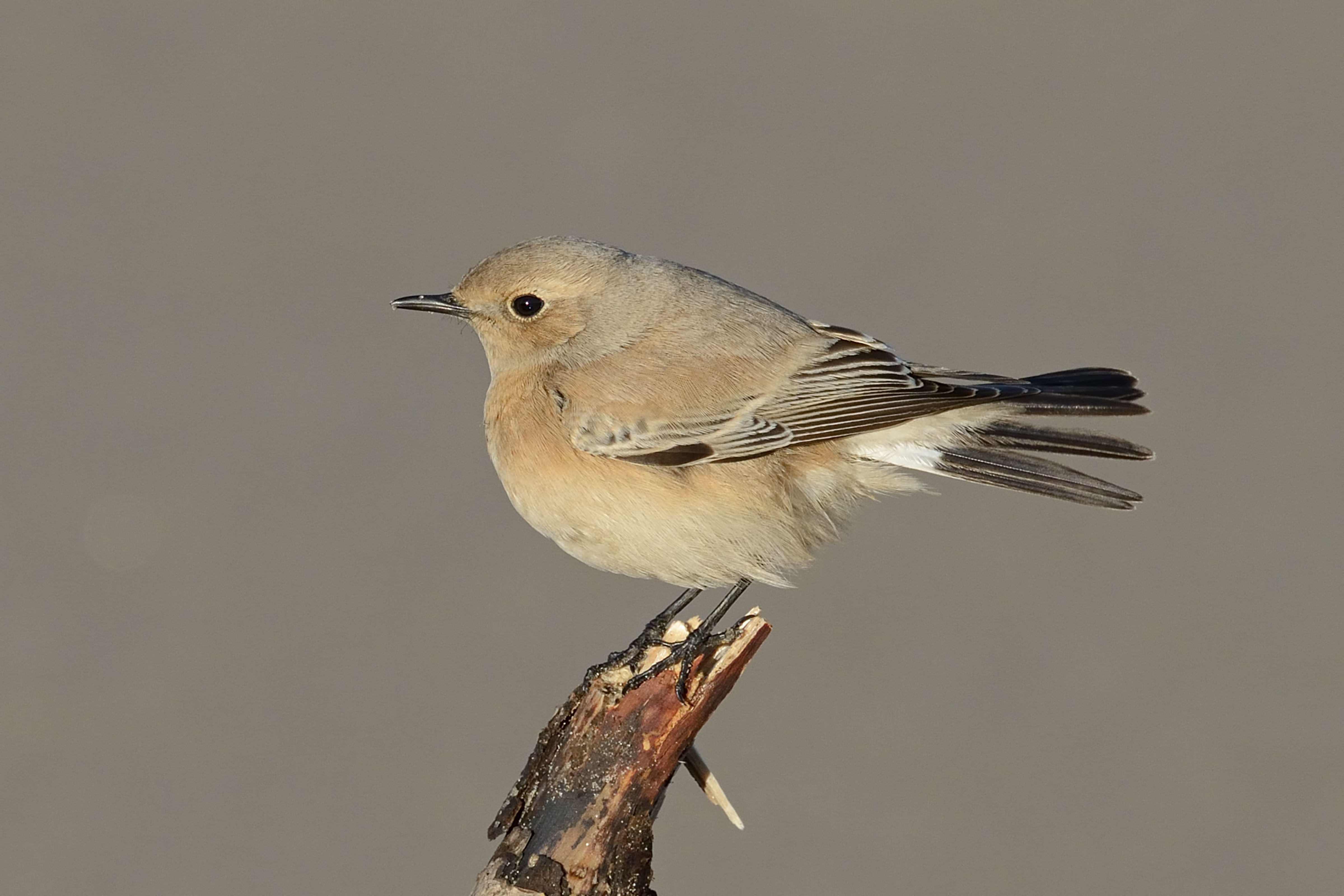
Desert Wheatear, Rhyl, Clwyd (Photo: Jon Taverner)
In the far north, the flock of Hornemann's Arctic Redpolls remained at Baltasound, Unst (Shetland) throughout the week while, at the opposite end of the country, two Little Buntings were discovered among a Reed Bunting flock on Rosenannon Downs (Cornwall) during late afternoon on 28th. Also in Cornwall, a juvenile Rose-coloured Starling was found at St. Columb Major on 26th–27th to add to the continuing bird still at Port Isaac.

Hornemann's Arctic Redpoll, Baltasound, Unst, Shetland (Photo: Mike Pennington)
A slight increase in Waxwing reports this week saw 868 messages disseminated on Bird News Extra; with cold weather beginning to grip the nation towards the end of the week it was no surprise to see a sudden surge into southern areas, with modest flocks appearing in Kent, Sussex, Surrey and Devon.

Waxwing, Tallington Lakes, Lincolnshire (Photo: Will Bowell)
Turning back to wildfowl, two white-morph Snow Geese were again seen on North Uist — this time at Knockintorran on 28th. The Orkney individual was again seen with Greylags at Outertown, while the Sheskinmore Lough (Donegal) white morph was also noted once more on 28th. The party of Todd's Canada Geese in Northumberland were noted at Bothal Pond, Woodhorn Flash and Queen Elizabeth II Country Park throughout the week, while a Richardson's Canada Goose was found with Canada Geese at Kilchenzie (Argyll) on 22nd and was still there on 27th. Further hutchinsii involved lingering birds still at Loch Gruinart, Islay on 25th, Loaningfoot (Dumf & Gall) on 27th and two still in Sligo on 28th. Black Brants were at Rosslare Backstrand (Wexford), Dungarvan (Waterford) and in Portsmouth (Hants), with the Farlington Marshes Red-breasted Goose making the short hop there on 27th. Furthermore, there was confirmation that there were indeed two Red-breasted Geese with wintering Barnacles in Scotland: the Dumfries bird was again seen at Cardurnock on 28th while the Islay bird was still at Loch Gruinart on 24th–25th.
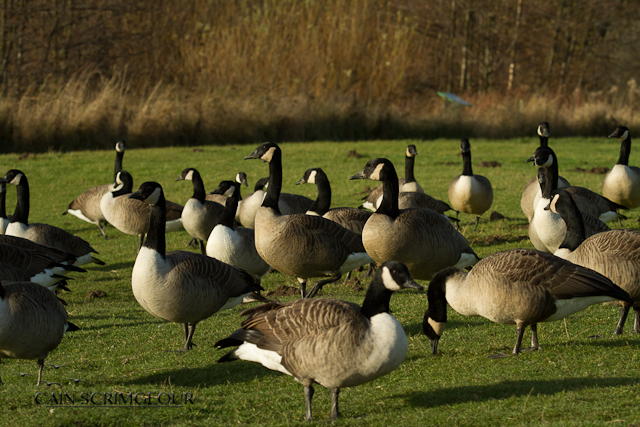
Todd's Canada Geese with Atlantic Canada Geese, Queen Elizabeth II CP, Northumberland (Photo: Cain Scrimgeour)

Richardson's Canada Goose, Kilchenzie, Argyll (Photo: John Nadin)

Red-breasted Goose, Cardurnock, Cumbria (Photo: Paul Kennedy)
In Kerry, a Blue-winged Teal was found at Ballylongford on 22nd. A new Green-winged Teal was at Loch of Kinnordy (Angus & Dundee) on 22nd–24th while others remained in Dumfries & Galloway, Cumbria, Lancashire and Wexford. The American Wigeon remained in West Yorkshire throughout. A drake Lesser Scaup at Soulseat Loch (Dumf & Gall) on 26th was considered a returning bird from previous winters, while the first-winter continued at Lough Gash (Clare) to 27th. Three Ring-necked Ducks remained on Tresco (Scilly) in addition to drakes still at Chew Valley Lake (Somerset) and Eyebrook Reservoir (Leics) and a female on Loch Eaval, North Uist on 28th. New Irish Surf Scoters were found off Dungarvan (Waterford) from 25th and Toe Head (Cork) on 28th in addition to the singleton still at Lahinch (Clare) on 25th and three still off the North Wales coast at Llanddulas. Colder weather towards the week's end saw the first notable arrival of Smew to southern and eastern areas, with perhaps as many as 20 reported.
The four White Storks over Bournemouth (Dorset) on 28th are presumably those that spent much of the summer touring the southern half of Britain; their return to our shores after reaching the Channel Islands back in August seems bizarre, but they were also seen in Dorset back in October. Glossy Ibis remained at Timoleague (Cork) and Marloes Mere (Pembrokeshire) and a couple of Cattle Egrets were on Jersey, while a similar tally of Great White Egrets to the previous week included up to four still at Dungeness (Kent) and an excellent Herefordshire record from Stretton Sugwas Pits on 25th–28th. Over in Kerry, the Common Crane remained near Ballinskelligs to 24th.

Great White Egrets, Dungeness RSPB, Kent (Photo: Martin Casemore)
Also in County Kerry, a Gyr Falcon was seen over Tralee during the afternoon of 27th, while the Northern Harrier also continued to show at Tacumshin (Wexford). Just one Rough-legged Buzzard report came in, from Rendlesham (Suffolk) on 22nd.
The wader picture was similar to that of recent weeks, with Long-billed Dowitchers remaining at Slimbridge (Glos) and Alkborough Flats (Lincs) and Lesser Yellowlegs also still in residence at Ernesettle (Devon) and Aldcliffe Marshes (Lancs). It will be interesting to see whether the impending cold weather has any bearing on their attempts to winter at their chosen sites.

Lesser Yellowlegs, Ernesettle, Devon (Photo: Tom Whiley)
Over in Northern Ireland, the Bonaparte's Gull was again seen in Larne harbour (Antrim) to 25th, while Cork stole the show for Ring-billed Gulls. A first-winter was at Adrigole (Cork) on 24th (with presumably the same bird at nearby Castletown Bearhaven on 27th) and there were returning birds in the county at Bantry and Rosscarbery, plus the long-stayer Timoleague. Others remained at Groomsport (Down) and Gosport (Hants). Ten or so Iceland Gulls included the usual adult roosting at Chasewater (Staffs) and the first juveniles noted in Clare, Kerry and Cork, while Glaucous Gulls were again headlined by the third-winter at Dungeness (Kent); the only multiple count was of two at Lamba Ness, Unst on 28th.

Ring-billed Gull, Bantry, Cork (Photo: Graham Clarke)
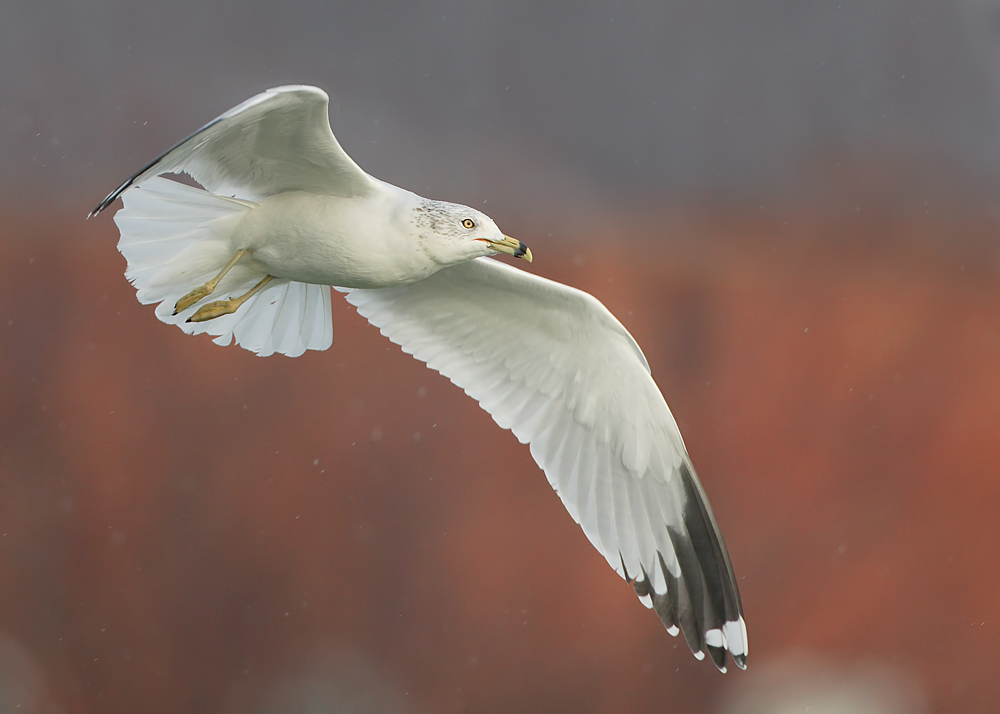
Ring-billed Gull, Gosport, Hampshire (Photo: Mick Southcott)
Photo of the Week
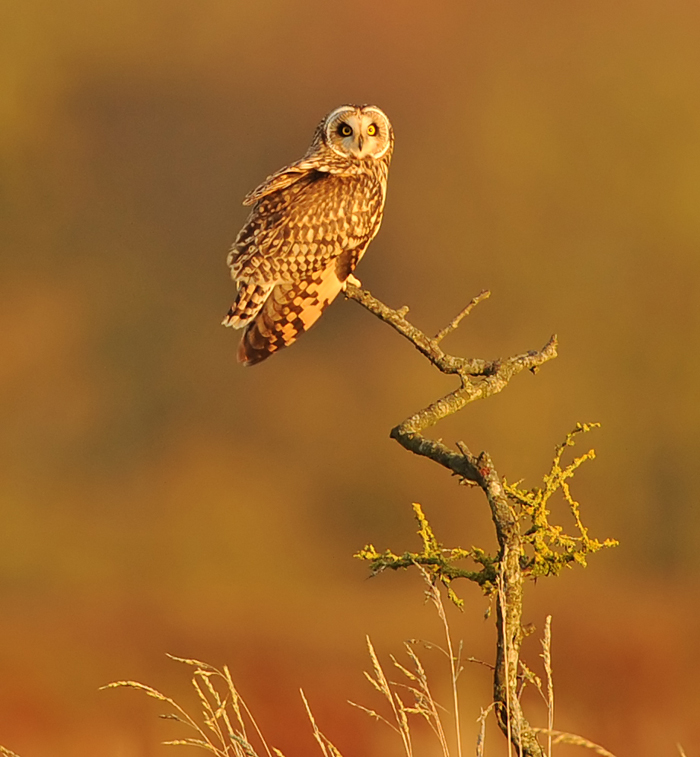
Short-eared Owl, Rawcliffe Moss, Lancashire (Photo: Brian Rafferty)
One of the key compositional choices to be made by bird photographers is how big the subject should appear in the frame. Most people first attempt to photograph a bird with a general-purpose camera, with the result that the bird ends up looking 'lost' in the frame due to lack of magnification. For people who then progress to buying more specialised equipment for bird photography, it's therefore understandable that they often over-react and become obsessed with showing the maximum amount of detail in the birds, to the extent that they literally fill the frame with the bird. This gives a claustrophobic feel to the image, with the subject appearing 'cramped', and gives no sense of place to the viewer. Thankfully, most bird photographers develop beyond that stage and recognise the value of having a range of different subject sizes depending on the situation: sometimes a head-and-shoulders close-up, sometimes a whole bird isolated in an otherwise featureless frame (but still with space to 'breathe') and sometimes showing the bird as a small element amid its natural environment. This week, Brian Rafferty gives us a great example of where a more expansive view is beneficial. Catching up with a Short-eared Owl in glorious afternoon sunlight, Brian produced an image that includes enough of the scene to really make you feel you were there and, equally importantly, makes the most of the zigzag branch to create an engaging lead-in line. If you habitually aim to take bird photos with the bird occupying the majority of the frame, it could be time to take a step back (literally) and rethink your approach.
Other notable images

Sparrowhawk, Laurieston, Dumfries & Galloway (Photo: Alan McFadyen)

Goldfinch, Wigan, Greater Manchester (Photo: Roy)

Collared Dove, Rainham Marshes RSPB, Greater London (Photo: Brian Harrison)

Rosy-patched Shrike, Kenya (Photo: Jeff Hazell)

Grey Phalarope, Yeo Estuary, Clevedon, Somerset & Bristol (Photo: Allan Chard)
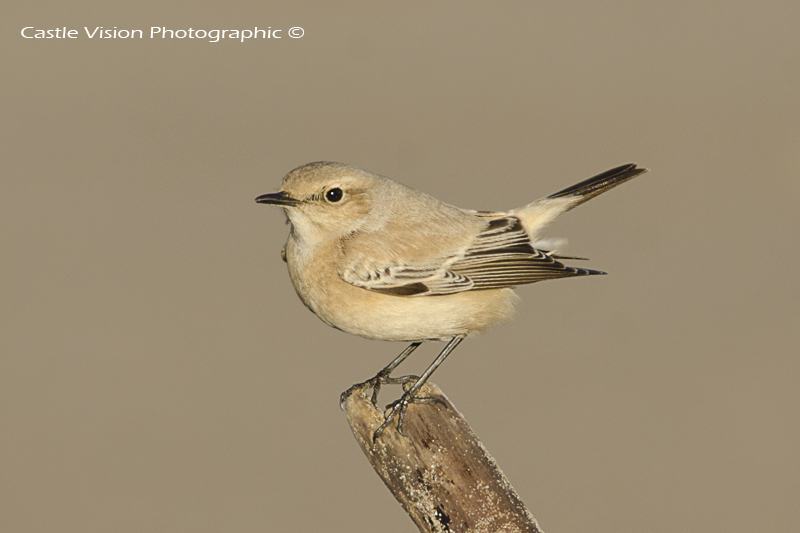
Desert Wheatear, Rhyl, Clwyd (Photo: Laurence Clark)

Spoonbill, Thornham, Norfolk (Photo: Peter Walkden)

Bearded Tit, Dunwich Pools, Suffolk (Photo: John Richardson)

Oriental Pied Hornbill, Singapore (Photo: Matt Fidler)

Jay, Ebbw Vale, Gwent (Photo: Mike Warburton)

Tawny Owl, Ipswich, Suffolk (Photo: Chris Upson)

Marsh Harrier, Cley Marshes NWT, Norfolk (Photo: Martin Lodge)

Nuthatch, Glazebury, Cheshire (Photo: John Tymon)

Brambling, Oakdale, Gwent (Photo: Andrew Symons)

Mistle Thrush, Hanley, Staffordshire (Photo: Steve Seal)


